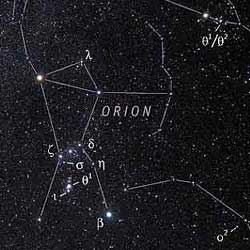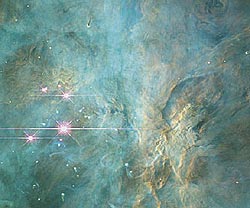
Due to its magnificent profusion of bright stars, Orion dominates the author's selection of seasonal doubles. Most of the doubles described in this article can be split with 3-inch (76-millimeter) telescopes, and several appear double even through binoculars.
Courtesy Akira Fujii.
People often wonder why astronomers get excited about observing two or three points of light in close proximity. Star clusters, nebulae, and galaxies seem more glamorous, but double stars are the underappreciated gems of the night sky. Unlike other deep-sky wonders, they are easily located and viewed even when the sky is hazy, moonlit, or light-polluted. They are suited for astronomers of all experience levels: many can be split easily at low magnifications, while others are a challenge even in the largest instruments. Their simplicity is deceptive; they display an endless variety of tints, magnitudes, separations, and (in the case of multiple stars) configurations. And literally thousands lie within reach of the smallest telescope.
My article "Double Stars for the New Year" on page 100 of the January 2005 issue of Sky & Telescope lists 25 of my favorite stellar pairs visible during the Orion season, and includes a table that provides much information about each. Here is a detailed description of eight of them.
Double Stars in Orion
Beta (b) Orionis, better known as Rigel, is one of the brightest stars in the sky. A companion 1/400 as bright lies just 10 arcseconds to its south, creating one of the most spectacular magnitude-contrast pairs in the heavens. Like most of the stars in Orion, both are hot B-type suns. In 1949, Sky & Telescope columnist Leland Copeland described Rigel as “a blue boy with a companion on his shoulder.” A 3-inch scope at 90x will show the little star on a steady night, but the larger the telescope, the more dramatic the effect. The view at 150x in a 14-inch scope is never to be forgotten!

The six brightest components of the Trapezium show well in this photograph from the Hubble Space Telescope.
Courtesy J. Bally, D. Devine, R Sutherland, and D. Johnson, NASA.
Theta1 (q1) Orionis is the famed multiple-star system lying at the heart of the magnificent Orion Nebula. Its four brightest components range from 5th to 7th magnitude, and even the smallest scopes resolve them into an irregular quadrilateral commonly called the Trapezium. These hot, newborn, O- and B-type suns shine bluish white like diamonds against the green of the nebula itself. Some observers even report seeing them suspended in front of the nebulosity, resulting in an amazing 3-D effect! Take a look and see if you do too.
Double stars’ components are usually named in order of brightness, but the bright Trapezium stars are lettered A, B, C, and D in order of right ascension, with C being the brightest. They are actually the most obvious members of a star cluster in formation. On a night of steady seeing, apertures as small as 4 inches will show the 11th-magnitude E and F stars. Much larger apertures are required to see components G and H. The A and B stars are eclipsing binaries with periods of 65 and 6.5 days, respectively.

The fine quadruple star Sigma (s) Orionis shares a high-power eyepiece field with the faint triple Struve 761. North is up.
Sky & Telescope illustration.
Sigma (s) Orionis is an amazing multiple-star system. Most amateur instruments will reveal a beautiful quadruple. Instead of a box-shaped configuration like the Trapezium, Sigma’s components are strung out in an irregular line with the 4th-magnitude primary near one end. Here again, all the stars are blue-white O- and B-type suns, but Sigma is often described as a colorful multiple system. Among the various hues reported here by both classical and modern observers are yellow, orange, red, grape red, ash, and pale gray. Adding to the beauty of the scene is Struve 761, a slender triangle of 8th-magnitude stars lying 210 arcseconds northwest of the Sigma complex. All the stars in this area appear to be moving through space together, forming a miniature star cluster.
Pretty Doubles in Orion's Vicinity
32 Eridani is an attractive but little-known pair lurking in the dim expanse of Eridanus due west of Orion’s Belt. Its 5th- and 6th-magnitude components are set 8 arcseconds apart and display lovely pale topaz-yellow and sea-green hues that are evident in a 3-inch telescope and are truly striking in a 6-inch scope at 50x. Italian astronomer Angelo Secchi described this pair’s colors as “magnificent, superb” — and they are! Try cranking the magnification up to 40x per inch of aperture to see this pair’s beautifully tinted diffraction disks.
A line through Orion’s belt stars extended downward points to Beta (b) Monocerotis, also called Herschel’s Wonder Star, which is regarded by many as the finest triple system in the sky. At very low magnifications it appears to contain only two components, but a 3-inch scope at 60x reveals it as three nearly identical 5th-magnitude blue-tinged suns of spectral type B3. Larger apertures and higher powers greatly improve its visual impact.
Sirius, Alpha (a) Canis Majoris, is one of the most fascinating and challenging doubles in the sky. The primary is the brightest and second-closest of all the naked-eye stars, and its faint companion is the nearest white dwarf to Earth. They are opening from their last minimum in 1993, at a separation of less than 3 arcseconds, on their way to the next maximum in 2022, when they will be 11 arcseconds apart.
Sirius B is aptly described by one observer as “frightfully difficult” to see when near minimum, requiring at least 12 inches of aperture and superb seeing conditions. At its current separation of 7 arcseconds, it is visible in an optically excellent 5- or 6-inch scope.
Southeast of Sirius near the eastern border of Canis Major lies the star h3945. Its 5th- and 6th-magnitude K- and F-type suns provide an outstanding color contrast reminiscent of the famous double star Albireo, so I’ve dubbed it the Winter Albireo. Even in a 2-inch scope at 25x, the reddish orange and sapphire tones will surprise and delight you.
Castor, Alpha (a) Geminorum, is the star that convinced William Herschel of the physical reality of binary systems. He plotted the relative motions of the components and concluded that they followed a curved path that could be due only to orbital motion — the first evidence that gravity operated outside the solar system.
Here we find radiant 2nd- and 3rd-magnitude blue-white A-type suns currently 4 arcseconds apart and an easy split in a 3-inch telescope at 100x or more. The pair is opening from its last minimum of 1.8 arcseconds in 1963 to its next maximum of nearly 8 arcseconds in 2120. In a 2.4-inch refractor at high magnification during the winter of 1963, the two stars could actually be seen closing and finally “merging” over a period of just a few months!
Seventy arcseconds south of the AB pair is 9th-magnitude Castor C, also known as YY Geminorum. This M-type reddish orange dwarf is an eclipsing binary that fades from its normal brightness by more than a half magnitude every 20 hours. Spectroscopic studies show that the A and B components are also binaries, with periods of 9 and 3 days, respectively, so Castor A, B, and C actually make up a sextuple system!
If you haven’t explored the world of double stars, this is a great season to start. Once you acquire the habit, you’ll have an endless store of objects to observe, each with its own unique personality.
 0
0
Comments
You must be logged in to post a comment.